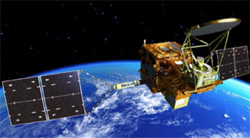Home > Highlighting JAPAN > Highlighting Japan AUGUST 2012 > Following the Flow of Water
Highlighting JAPAN
[SERIES] SCIENCE & TECHNOLOGY
Following the Flow of Water
The existence of all of the living things on the so-called water planet, Earth, is dependent upon the movement of water circulating in the oceans, on land and in the atmosphere. To observe this circulation of water on a global scale, the satellite Shizuku was launched in May of this year. Takashi Sasaki reports.

A one-full-day observation image of the Earth by the AMSR2 (Advanced Microwave Scanning Radiometer 2) aboard Shizuku from 9:00 a.m. on July 3 (JST) to July 4. In this image, the whitish-yellow parts indicate areas of heavy rain or sea ice, the light blue parts are areas with little water vapor in the atmosphere or thin clouds, the dark blue parts are areas with more water vapor in the atmosphere or thicker clouds, and the black color parts are areas that were not observed for one day.
Credit: COURTESY OF JAXA
So says Keizo Nakagawa, who works as the Shizuku project manager at the Japan Aerospace Exploration Agency (JAXA). (In Japanese, shizuku means a drop of water.)
Shizuku, which was launched from the Tanegashima Space Center in May of this year, is one of the artificial satellites used in the Global Change Observation Mission (GCOM) and is the first of the GCOM-W series that will make microwave observations. The most important feature is a high performance, scanning microwave radiometer with an antenna of a diameter of two meters. This sensor is able to detect the very weak microwaves emitted by water molecules on the Earth's surface from an altitude of approximately 700 kilometers and can not only precisely measure sea surface temperature to an accuracy of within 0.5属C, it can also observe the volume of water vapor in the atmosphere, the amount of precipitation, the quantity of snowfall, the distribution of sea ice and the amount of water in soil.
Shizuku's microwave sensor unit, which weighs about 200 kilograms including the antenna, rotates once every 1.5 seconds and can scan approximately a 1,450 kilometer swath of Earth's surface during each rotation. Shizuku, which takes about 100 minutes to orbit the Earth, can observe almost the entire surface of Earth in just about two days.
"Of course, on land, there are a countless number of weather observation stations but, in the end, these cover no more than a single point. There are a small number of observation points on the surface of the ocean in particular. Therefore it can be said that the continuous, uninterrupted observation of the surface is Shizuku's biggest advantage. When the climate changes, the water circulation is sensitively responded, and therefore using the observation data we will be able to make more accurate simulations of future climate change," Nakagawa says.

Shizuku, Japan's contribution to the A-Train Earth observation satellite constellation run by NASA
Credit: COURTESY OF JAXA
"The significance of the A-Train is that we can now observe the same area at just about the same time using completely different sensors. By sharing the data gathered in this manner, figuratively speaking would be like taking an image of the surface of Earth that had been seen as only a single, flat photograph and making it into a completely three-dimensional image that can be seen in great detail," says Nakagawa.
Shizuku is expected to be used for five years and then its function will be continued by a No. 2 and a No. 3 satellite. This observation data collected uninterrupted for more than ten years is expected to steadily take signs of climate change that might not be noticed from the ground. In addition, JAXA's processing data of Shizuku will not only be given to research institutions and operational organizations but will be available to the public soon after the observation through its website. If this data is used, it is expected not only to greatly improve the precision of weather forecasts throughout the world, it is hoped that it will be a big help to agriculture, fishing, transportation and tourism and other industries that are closely tied to people's lives.
© 2009 Cabinet Office, Government of Japan






